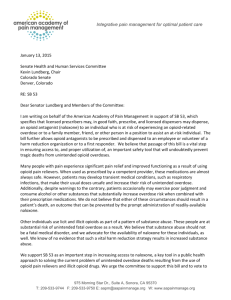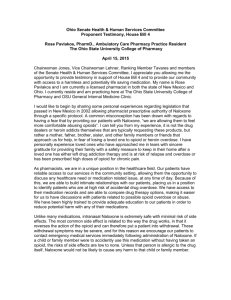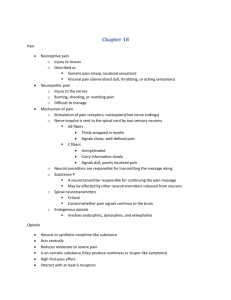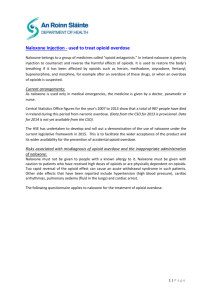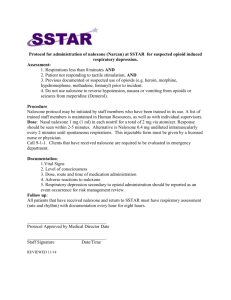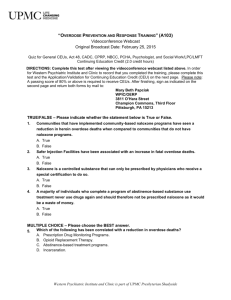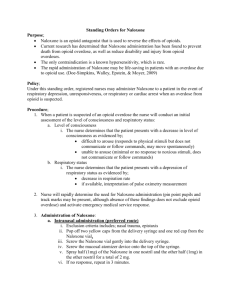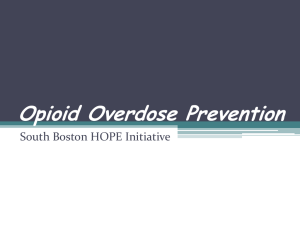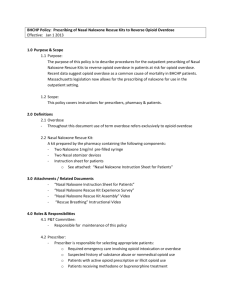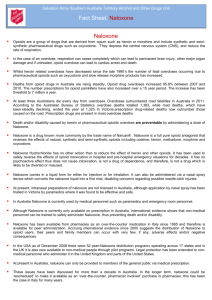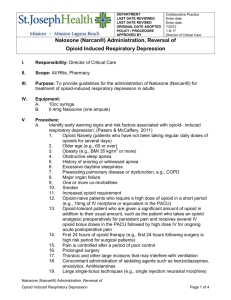here
advertisement
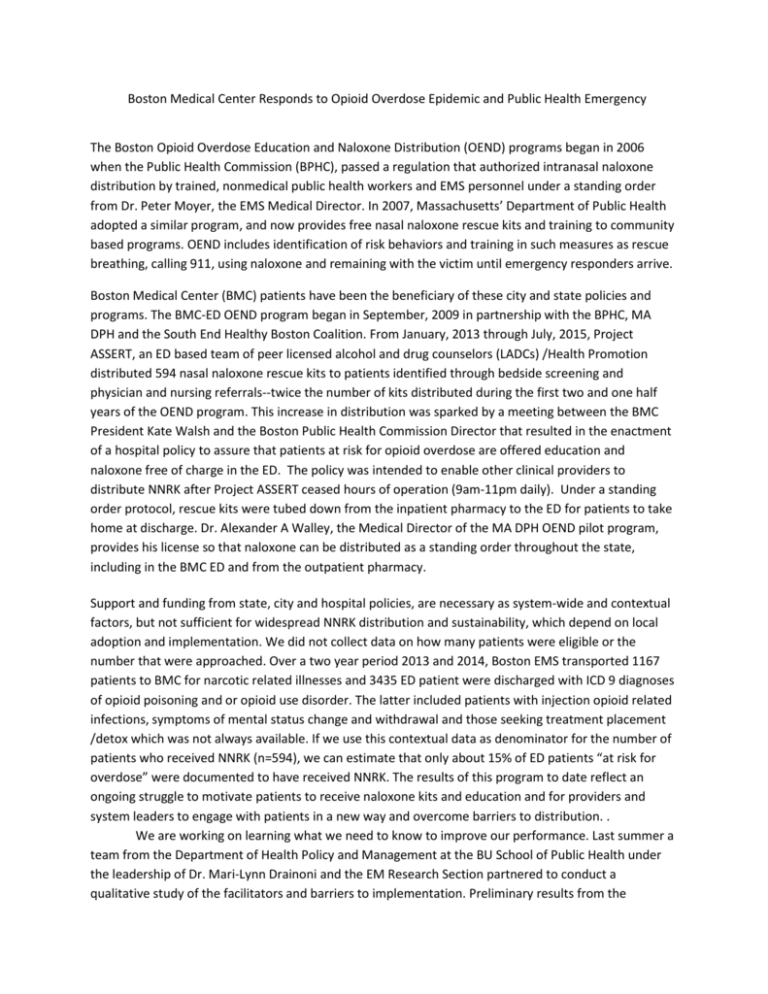
Boston Medical Center Responds to Opioid Overdose Epidemic and Public Health Emergency The Boston Opioid Overdose Education and Naloxone Distribution (OEND) programs began in 2006 when the Public Health Commission (BPHC), passed a regulation that authorized intranasal naloxone distribution by trained, nonmedical public health workers and EMS personnel under a standing order from Dr. Peter Moyer, the EMS Medical Director. In 2007, Massachusetts’ Department of Public Health adopted a similar program, and now provides free nasal naloxone rescue kits and training to community based programs. OEND includes identification of risk behaviors and training in such measures as rescue breathing, calling 911, using naloxone and remaining with the victim until emergency responders arrive. Boston Medical Center (BMC) patients have been the beneficiary of these city and state policies and programs. The BMC-ED OEND program began in September, 2009 in partnership with the BPHC, MA DPH and the South End Healthy Boston Coalition. From January, 2013 through July, 2015, Project ASSERT, an ED based team of peer licensed alcohol and drug counselors (LADCs) /Health Promotion distributed 594 nasal naloxone rescue kits to patients identified through bedside screening and physician and nursing referrals--twice the number of kits distributed during the first two and one half years of the OEND program. This increase in distribution was sparked by a meeting between the BMC President Kate Walsh and the Boston Public Health Commission Director that resulted in the enactment of a hospital policy to assure that patients at risk for opioid overdose are offered education and naloxone free of charge in the ED. The policy was intended to enable other clinical providers to distribute NNRK after Project ASSERT ceased hours of operation (9am-11pm daily). Under a standing order protocol, rescue kits were tubed down from the inpatient pharmacy to the ED for patients to take home at discharge. Dr. Alexander A Walley, the Medical Director of the MA DPH OEND pilot program, provides his license so that naloxone can be distributed as a standing order throughout the state, including in the BMC ED and from the outpatient pharmacy. Support and funding from state, city and hospital policies, are necessary as system-wide and contextual factors, but not sufficient for widespread NNRK distribution and sustainability, which depend on local adoption and implementation. We did not collect data on how many patients were eligible or the number that were approached. Over a two year period 2013 and 2014, Boston EMS transported 1167 patients to BMC for narcotic related illnesses and 3435 ED patient were discharged with ICD 9 diagnoses of opioid poisoning and or opioid use disorder. The latter included patients with injection opioid related infections, symptoms of mental status change and withdrawal and those seeking treatment placement /detox which was not always available. If we use this contextual data as denominator for the number of patients who received NNRK (n=594), we can estimate that only about 15% of ED patients “at risk for overdose” were documented to have received NNRK. The results of this program to date reflect an ongoing struggle to motivate patients to receive naloxone kits and education and for providers and system leaders to engage with patients in a new way and overcome barriers to distribution. . We are working on learning what we need to know to improve our performance. Last summer a team from the Department of Health Policy and Management at the BU School of Public Health under the leadership of Dr. Mari-Lynn Drainoni and the EM Research Section partnered to conduct a qualitative study of the facilitators and barriers to implementation. Preliminary results from the interviews with nurses, physicians, pharmacists and Project ASSERT staff revealed general support for policy goals but multiple barriers to distribution. Patient barriers included lack of receptivity to NNRK, patients not accompanied to the ED by a supportive other who might be present at a future event to administer naloxone, and many individuals who were not open to learning about overdose prevention but just wanted to leave and address their withdrawal symptoms after an overdose reversal in the ED or the field. Many patients were initially hesitant to accept rescue kits because they feared that they would be at risk for arrest or police harassment for possession of naloxone if they called 911, and remained at the scene. Additionally a significant number of patients had received NNRK. Staff barriers included unfamiliarity with policy, lack of clarity regarding responsibility for education and distribution, lack of consensus about which patients are appropriate for NNRKs. Process barriers included: unclear method to obtain the kit, confusion around the legality of a standing verbal order, lack of integration of NNRK into the EMR, and difficulty tracking data about distribution. Staff suggestions to improve uptake included uniform and targeted training, role clarification, integration into EMR and restructuring implementation. In response to these findings, we implemented a change in the EPIC EMR’s common order panel that enabled the physicians to electronically order NNRK, an order that goes directly to our night ED pharmacist who distributes the kits, and together with nursing, and evening SW provide patient training and education. The EMR fix simplified the process and eliminated the need for the standing orders paper forms as specified in the original policy. In addition the night social worker was crossed-trained in OEND, and now works collaboratively with staff and pharmacy to reach more patients. During house staff orientation, Dr. Lauren Nentwich together with Project ASSERT staff provided NNRK training for over one hundred new interns. Just as BMC ED needs a hospital-wide collaboration and continuous quality monitoring and improvement to extend the reach of NNRK, Massachusetts and the nation needs all its EDs and hospitals to implement OEND programs. In 2014, Massachusetts reported 1246 deaths over twice the death reported in 2012 and the trend continues in the first quarter of 2015 with 312 deaths. Despite great strides, we face the reality that opioid addiction is a challenging, highly stigmatized complex bio-psychosocial problem that we are only beginning to address in the medical setting. Opioid overdose education and naloxone distribution and referral to quality modalities of treatment including constitute strategies on the demand side of the equation. However, as a society and professionals we will be less than effective if we neglect the supply side--the market place of narcotic prescriptions and diversion and the highly organized industry of street sales of opioid and heroin. Prescriber education, and the use of the Prescription Monitoring Program, and pharmacy drug take back programs are additional strategies. We need to bring together science, medicine, public health and law enforcement to comprehensively address this epidemic. We have made important strides, yet there’s still much work to be done and our nation’s emergency departments have an important role to play.
